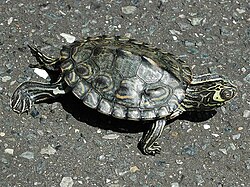| Barbour's map turtle | |
|---|---|
 | |
| Graptemys barbouri, hatchling | |
| Scientific classification | |
| Kingdom: | Animalia |
| Phylum: | Chordata |
| Class: | Reptilia |
| Order: | Testudines |
| Suborder: | Cryptodira |
| Family: | Emydidae |
| Genus: | Graptemys |
| Species: | G. barbouri |
| Binomial name | |
| Graptemys barbouri | |
 | |
| Range map | |
| Synonyms | |
Barbour's map turtle (Graptemys barbouri) is a species of turtle in the family Emydidae. The species is native to the southeastern United States.

